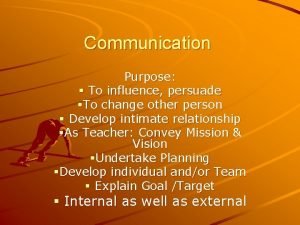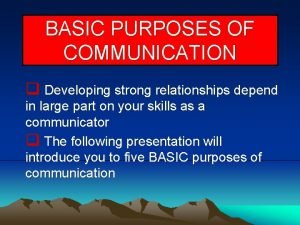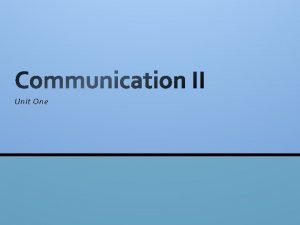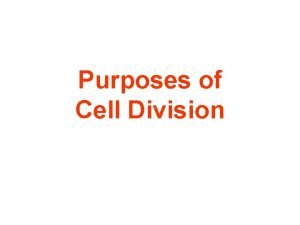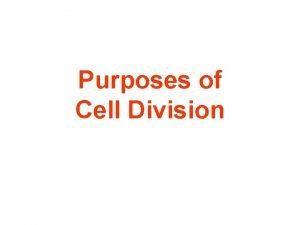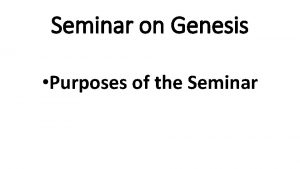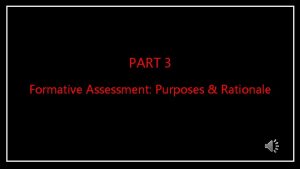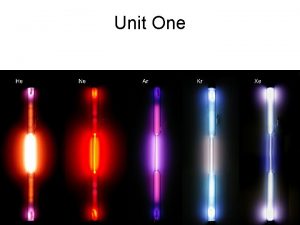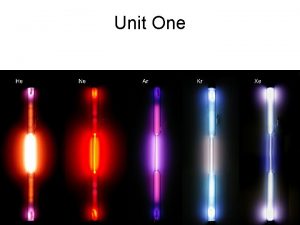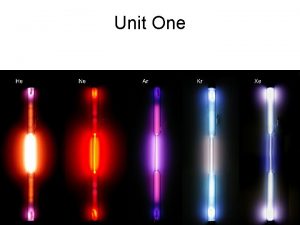Unit One What is communication Purposes of Communication













- Slides: 13

Unit One

What is communication?

Purposes of Communication • Communication acts to control member behaviour. • Communication fosters motivation by clarifying to employees what is to be done, how well they are doing it, and what can be done to improve performance if it’s subpar. • Communication provides a release for emotional expression of feelings and for fulfillment of social needs. • Communication facilitates decision making. It provides the information that individuals and groups need to make decisions by transmitting data to identify and evaluate alternative choices

Formal and Informal Communication Formal communication networks are systems designed by management to dictate who should talk to whom to get a job done. While informal communication networks are patterns of interaction based on friendships, shared personal or career interests, and proximity. Functions of informal communication within an organization Confirming- Some informal communication confirms formal messages. Expanding- Information communication can help fill in the gaps left by incomplete formal messages. Expediting- Informal networks can often deliver messages more quickly than official channels can.

Routes of Communication The most common way of describing communication networks is with organizational charts. Organizational charts show that communication can flow in several directions: upward, downward, and horizontally

Downward Communication. This occurs whenever superiors initiate messages to their subordinates. There are several types of downward communication: Job instructions. Directions about what to do and who to do it. Job rationale. Explanations of how one task relates to other tasks. Procedures and Practices. Information about rules, regulations, policies, and benefits. Feedback. Information about how effectively a person is performing. Indoctrination. Information aimed at motivating employees by impressing the organization’s mission upon them specifying how they should relate to it.

Potential Benefits and Problems of Downward Communication Potential Benefits. Prevention or correction of employee errors. Greater job satisfaction. Improved morale. Potential Problems. Insufficient or unclear messages. Message overload Message distorted as it passes through one or more intermediaries.

Upward Communication Messages flowing from subordinates to superiors are labeled upward communication. Upward communication can convey four types of messages: *What subordinates are doing. * Unsolved work problems. * Suggestions for improvement. * How subordinates feel about each other and the job.

Potential Benefits and Problems of Upward Communication Potential Benefits. Prevention of new problems and solution of old ones. Increased acceptance of management decisions. Potential Problems Superiors may discourage, disregard, or downplay importance of subordinates’ messages. Supervisors may unfairly blame subordinates for unpleasant news.

Horizontal/ Lateral Communication It consists of messages between members of an organization with equal power. The most obvious type of horizontal communication goes on between members of the same division of an organization: office workers in the same department, co-workers on a construction project, and so on. In other cases lateral communication occurs between people from different areas: accounting calls maintenance to get a machine repaired, hospital admissions calls intensive care to reserve a bed, and so on.

Five Purposes of Horizontal Communication Task Coordination. Problem solving Sharing information Conflict resolution Building rapport

Potential Benefits and Problems of Horizontal Communication Potential Benefits Increased cooperation among employees with different duties Greater understanding of organization’s mission. Potential Problems Rivalry may occur between employees from different areas. Specialization makes understanding difficult. Information overload discourages contact. Physical Barriers discourage contact. Lack of motivation.

Summary The absence of formal channels reduces communication effectiveness. Organizations must provide adequate upward, downward and horizontal communication in the form of employee surveys, open-door policies, newsletters, memos, task forces, and liason personnel. Without these formal channels, the organization cannot communicate as a whole.
 What is the purpose of machines
What is the purpose of machines Developing oral and online presentations
Developing oral and online presentations The purposes of communication
The purposes of communication Basic purposes of communication
Basic purposes of communication Horizontal communication
Horizontal communication One god one empire one emperor
One god one empire one emperor Little dog run
Little dog run One king one law one faith
One king one law one faith One empire one god one emperor
One empire one god one emperor One team one plan one goal
One team one plan one goal See one do one teach one
See one do one teach one See one, do one, teach one
See one, do one, teach one Structure of twelfth night
Structure of twelfth night See one do one teach one
See one do one teach one


